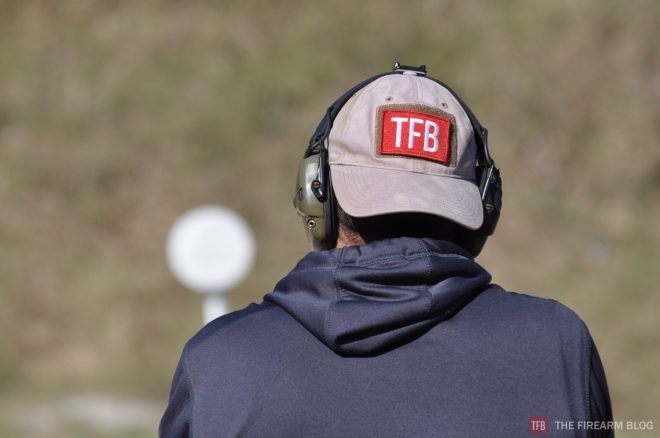Competitive shooting can be a fun and effective way to improve your shooting skills. Specifically, the Steel Challenge Competition can be a great way to get your foot in the door in the competitive world. Other competitions can have a large set of complex rules, expensive equipment requirements and hours upon hours of dedication and training to even start making the experience rewarding.
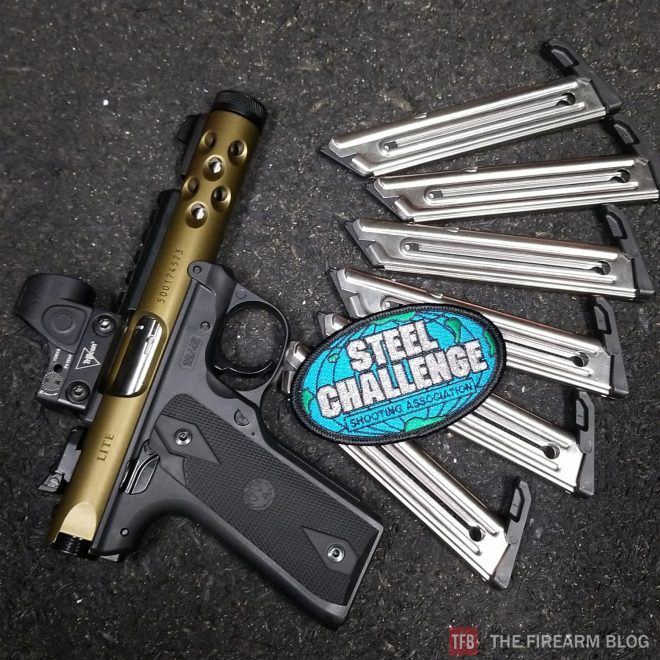
The Rimfire Report: Rimfire Steel Challenge
Today we’ll look at the Steel Challenge competition from the eyes of a rimfire competitor. We’ll see just how simple, inexpensive and fun this competition can be for the rimfire shooter.
What is the Steel Challenge Competition?
To put it simply, the Steel Challenge competition is a 5 target speed shooting competition. 5 targets are set up in certain arrangements and the shooter then hits each of the 5 targets. There is no specific order in which the targets need to be shot with the exception of one, the stop plate.
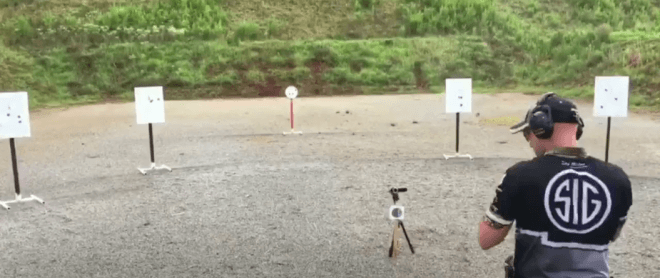
The Rimfire Report: Rimfire Steel Challenge – An Example of a popular Steel Challenge Stage called “Smoke and Hope” Note the red post stop plate at the center of the 5 plate array.
Competitors rarely need to move from their original shooting position during the course of fire so this makes for a very simple procedure to follow. In addition to these very few and simple rules, almost anyone who owns any type of firearm can compete in the steel challenge, including rimfire pistol and rifle owners.
Each course of fire is shot five times and the shooter’s score is the time they need to shoot the stage five times plus any penalties for missed shots, engaging targets from outside the shooting area and other infractions. The scores for each stage are totaled up, and the winner of the match is the person with the lowest overall score.
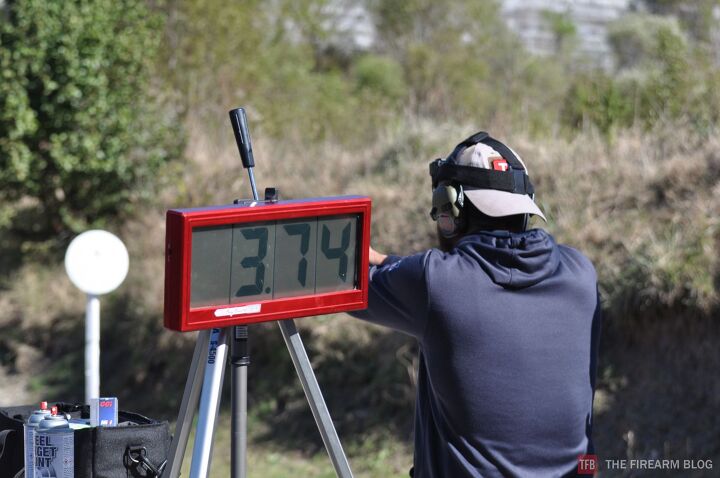
The Rimfire Report: Rimfire Steel Challenge
Steel Challenge – Required equipment
What specific equipment you’ll need is entirely up to your selected division. There are two main divisions in Rimfire Steel Challenge: Open, with allows for the use of red dot sights and other optics on your rifle and pistol, and Irons, which requires iron sights to be used on both guns. As Steel Challenge is designed to allow for an easy transition to the other practical shooting sports, these divisions closely match the setup for centerfire rifles and pistols in other sports.
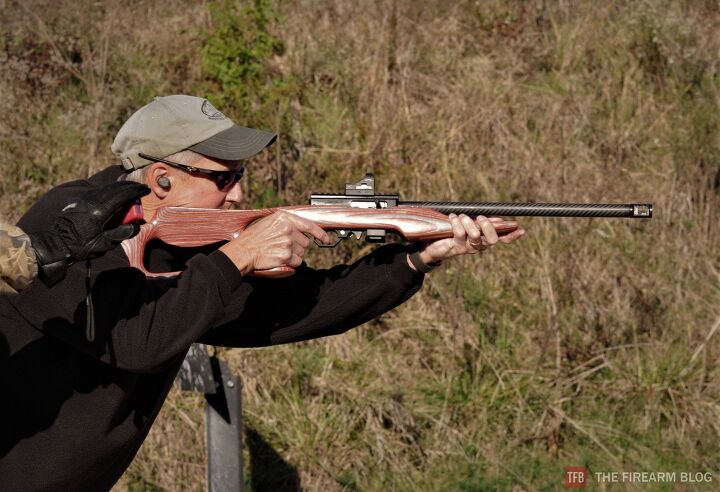
The Rimfire Report: Rimfire Steel Challenge
Unlike bigger competitions like 3-Gun and USPSA competitions, Steel Challenge requires very little equipment to get started. Most people can get by with a basic reliable firearm. All makes, models and styles of .22 Long Rifle firearms are allowed in the Steel Challenge Competition. In this section we’ll go over a few items you’ll want to bring to your first competition and from there you can decide what works best for you.
Ammunition
Each Stage will require the shooter to shoot a minimum of 25 rounds of ammunition. Each stage consists of 5 strings of fire. Although you could get away with only bringing 3 10-round magazines, it is advisable to bring one magazine for each “string” of shooting. New and inexperienced shooters especially should bring extra ammunition just in case each string takes more than 5 rounds to complete.
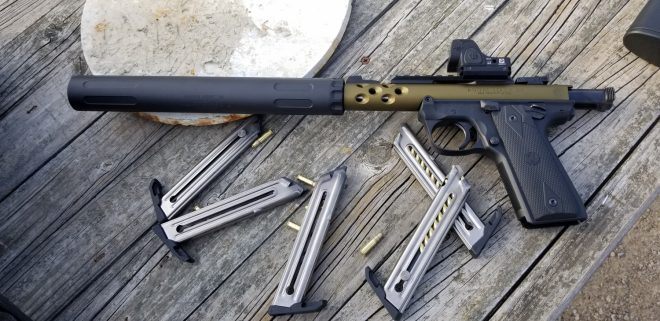
Note: Suppressors are one of the few aftermarket accessories that are not allowed in Steel Challenge competitions.
Personally, I bring about 500 rounds of ammunition to cover two matches. Ammunition type should be whatever works reliably in your gun without breaking the bank. Bricks of 100 CCI Mini-Mags can be had for as little as $7 making an entire competition cost about $21 if you shoot one match.
Steel Challenge Rimfire Rifles
In Steel Challenge there is no limitation as to what type of rimfire pistol or rifle you can use. If speed is what you’re after then a semi-automatic pistol or rifle will be the best option but there is nothing stopping you from using a lever action or bolt action rifle. I have seen on a couple of occasions some lever-action rifles be used for the rimfire competition and it looked like a lot of fun.
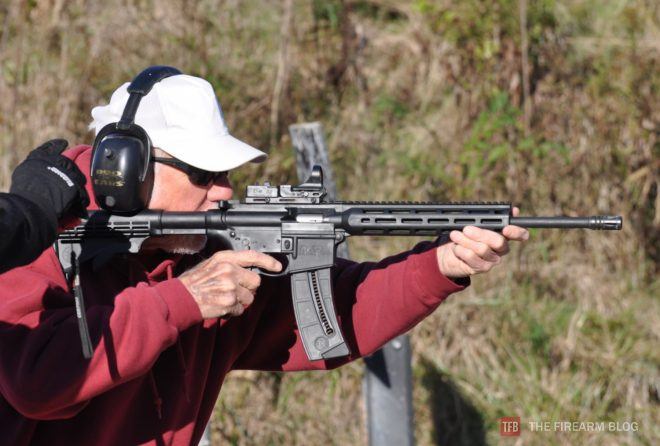
The Rimfire Report: Rimfire Steel Challenge – An Example of an AR-style .22 rifle used for steel challenge
The two most popular types of rifles used are the Ruger 10/22 and AR-15 style .22LR rifles. With the 10/22 you can go off the rails with customization. Some frequent participants go to great lengths to fine-tune their rifles to suit their exact style and preference.
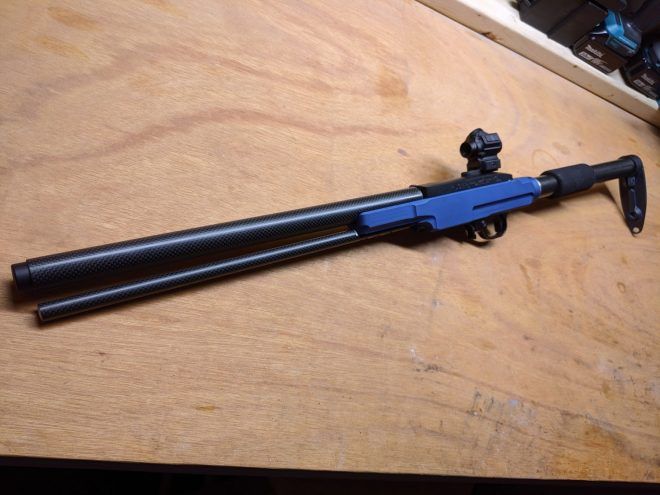
The Rimfire Report: Rimfire Steel Challenge Photo Credit: Reddit User: I_am_Axel This highly modified Ruger 10/22 is extremely lightweight and features more carbon fiber than a souped-up Honda Civic
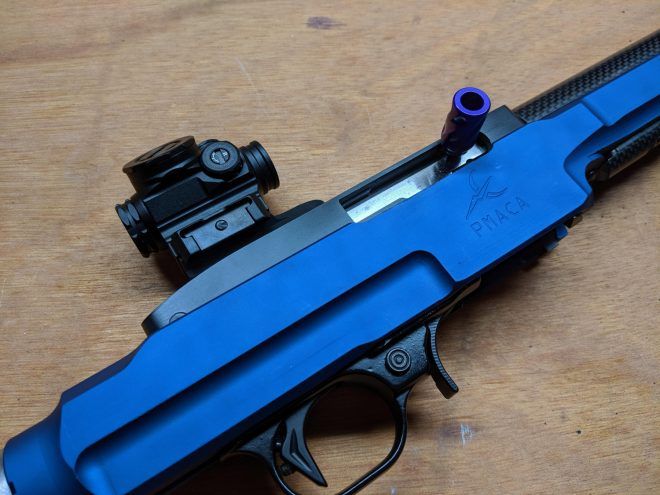
The Rimfire Report: Rimfire Steel Challenge Photo Credit: Reddit User: I_am_Axel
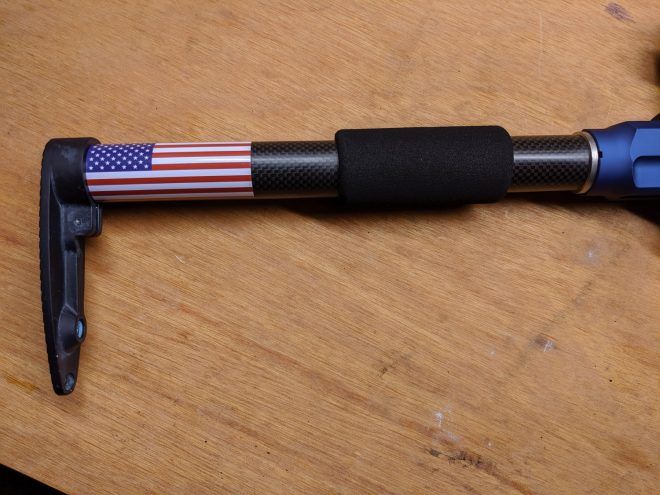
The Rimfire Report: Rimfire Steel Challenge Photo Credit: Reddit User: I_am_Axel
While a lot of people may show up to your first match with decked out race guns, don’t be intimidated. Rimfire Irons is completely fine and the courses are designed so that 90% of shooters can hit all of the targets 90% of the time.
Steel Challenge Rimfire Pistols
The most common options here will be the Browning Buckmark and the Ruger Mark series of pistols. Personally, I run a Ruger Mk IV right now, but in the past, I have run 1911 clones chambered in .22LR as well as Smith & Wesson Victory pistols. Again the general rule here is to use whatever works best for you.
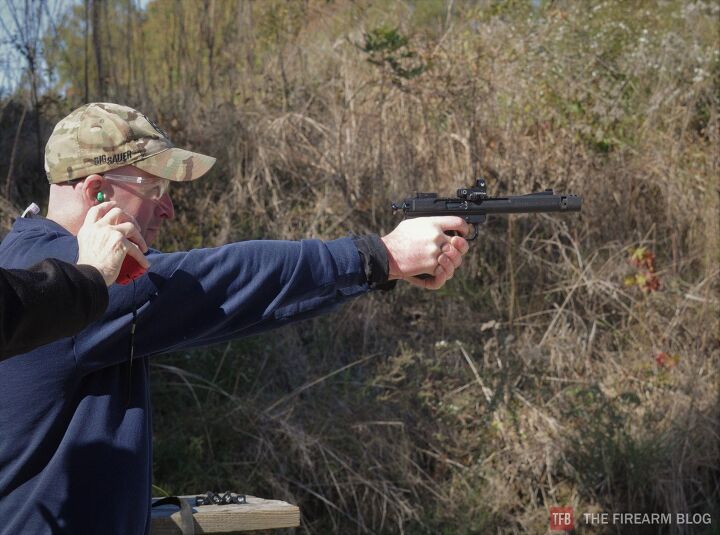
The Rimfire Report: Rimfire Steel Challenge – An example of a Volquartsen .22 Rimfire Pistol
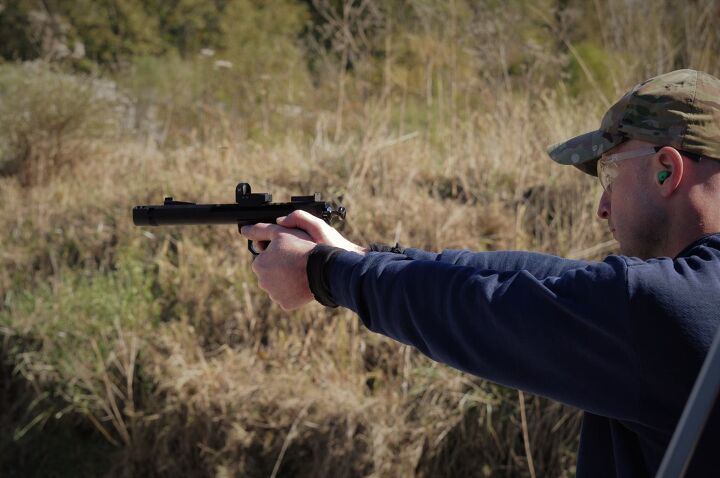
The Rimfire Report: Rimfire Steel Challenge – An example of a Volquartsen .22 Rimfire Pistol
The reason I settled on the Mark series of pistols for long term use is that they undoubtedly have the most aftermarket support. So much so that Volquartsen has made entire clones of the Mark series of pistol specifically designed for target and competition use.
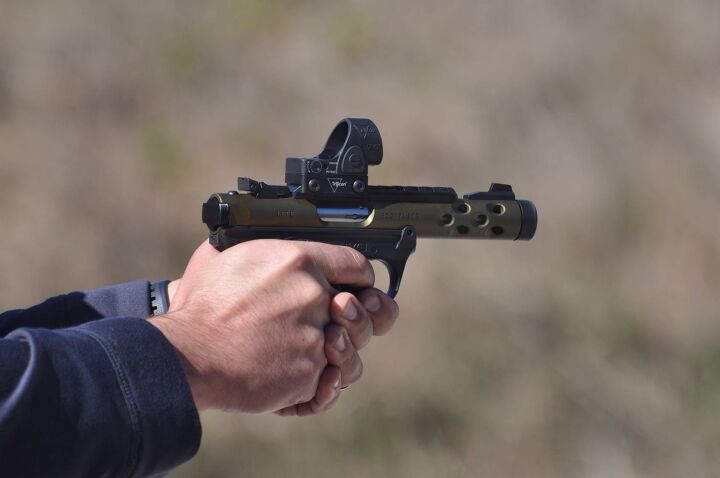
The Rimfire Report: Rimfire Steel Challenge – Ruger Mk. IV pistol Fitted with a Trijicon SRO
Holsters?
All rimfire competitors start each string of fire from the “low and ready” position. There is usually a cone or flag to denote the position the firearm should be pointed in before the timer beeps and you begin your string of fire. This further opens up the door for all shooters as there is no need to bring a holster. Furthermore, there is no need to worry about drawing from a holster when shooting a rimfire caliber firearm.
The courses of fire
There are a total of 8 official stages for the Steel Challenge competition. Each stage is the same regardless of division so rimfire shooting is a great way to introduce yourself to each stage without incurring a massive cost at the front end.
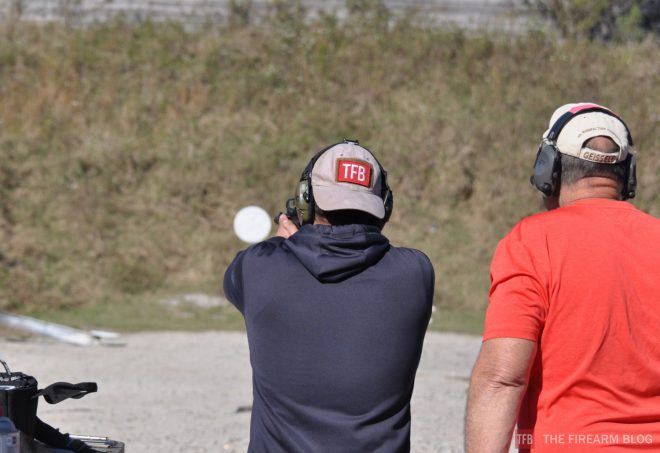
Each Steel Challenge competition will consist of several stages which each contain different courses of fire. I’ll do my best to detail each one here and provide a short clip of each stage. Again, there is no “correct” way to shoot the stage as long as the stop plate is the last target you hit!
Outer Limits
Outer Limits is the exception to the general rule of Steel challenge Stages. In this stage, the shooter engages the first two targets from one spot before transitioning left or right to the middle position to engage the remaining three targets. Easily considered to be one of the hardest steel challenge stages out there.
Five To Go
Five to Go is an extremely simple stage. Earlier I said there was no “wrong” way to shoot a stage. I kind of take that back with 5 to go as you’d have to be insane to shoot it any other way than left to right.
Speed Option
Speed option is a long-distance stage where higher velocity ammo can come in handy for top-tier competitors. Each of the plates is spaced pretty far apart compared to other stages and they are relatively far away. This makes the sound of the steel ringing happen much later delaying any follow up shots.
Pendulum
Pendulum seems simple but ends up being tricky because of the inner plates being smaller but at the same distance as the larger two outer plates. Best practice for this stage, in my opinion, is to shoot one side and then follow up by shooting from the outside in towards the Stop Plate to cut down on transitions.
Showdown
Showdown requires the shooter to shoot from two different positions for two or three out of the 5 strings of fire. Which box you decide to shoot two or three strings from is entirely up to you and usually boils down to preference.
Roundabout
Roundabout is deceptively easy. Depending on where you stand inside the shooting box, the targets can look closer or further apart. This stage for me and a lot of other shooters is the 2nd fastest stage alongside Smoke and Hope.
Accelerator
The Accelerator’s name follows its title. The closest two targets are on the complete opposite side of the following two targets. and the stop plate is placed on its own distance separate from any of the targets. This stage forces the shooter to accommodate not only large transition windows but also varying engagement distances and target sizes.
Smoke and Hope
Smoke and Hope Can be looked at in one of two ways. For new shooters, this stage can be seen as a much-needed confidence booster after completely bombing some of the other stages. For some more seasoned shooters including Grand Masters, this stage can be the bane of your existence.
Smoke and Hope has the largest target setup out of the 8 stages but it also forces the shooter to make the widest horizontal muzzle travel in any of them. This leads to many budding competitors to overshoot targets and make penalizing make-up shots further increasing their score time.
Get out and compete
The Steel Challenge competition is a great training tool, lots of fun and a great way to make new shooting friends. The competition has a lot to offer every shooter of any discipline including rimfire shooters. With the low entry cost of just a rimfire firearm, $50 of ammo and a couple spare magazines, a shooter of any skill level can participate and have a great time in the Steel Challenge Competition.
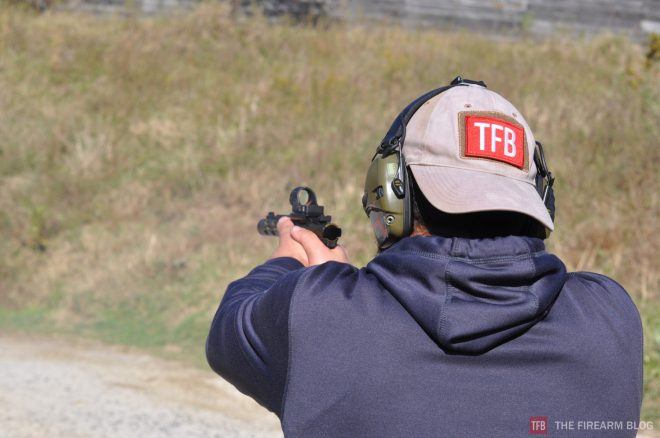
The Rimfire Report: Rimfire Steel Challenge
If anyone is interested in competing in the Steel Challenge competition in any division feel free to send me a direct message on Instagram and I’ll be happy to help out. I have been competing in Steel Challenge since 2012 and I have a wealth of success and failure stories from my experiences.
As always thanks for reading The Rimfire Report and we look forward to seeing you all in the next edition. Take care and keep on plinking my rimfire brothers!
I’d like to extend a personal thanks to John Carter. John took a vast majority of the photos used for this article and also participated in the steel challenge competition alongside me in the same division. John has his own personal YouTube Channel. So feel free to check out his channel!
 Your Privacy Choices
Your Privacy Choices
